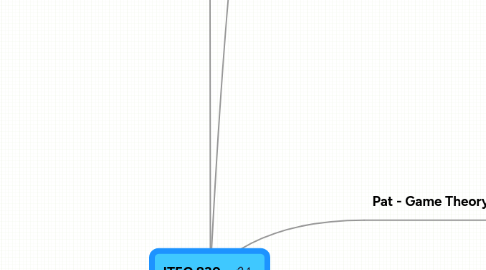
1. Emerging Technologies that facilitate Instruction
1.1. web 2.0 technologies
1.1.1. Wiki
1.1.1.1. pbworks
1.1.1.2. pbwiki
1.1.2. Blogs
1.1.2.1. Vlog (Video Blog)
1.1.2.2. microblogs
1.1.2.2.1. soup.io
1.1.2.2.2. Sina
1.1.2.2.3. DailyBooth
1.1.2.2.4. FanVibe
1.1.2.2.5. yammer
1.1.2.2.6. Twitter
1.1.2.2.7. Tumblr
1.1.2.2.8. plurk
1.1.2.2.9. Edublogs
1.1.2.2.10. Posterous
1.1.2.2.11. Twaud
1.1.2.3. curated content
1.1.2.3.1. Quiki
1.1.2.3.2. Quora
1.1.3. chat
1.1.3.1. Skype
1.1.3.2. Facetime
1.1.3.3. HipChat
1.1.3.4. Yammer
1.1.3.5. TalkShoe
1.1.3.6. Vyew
1.2. Mobile tools
1.2.1. Mobile Applications
1.2.1.1. Mobl21
1.2.1.2. Black Board
1.2.1.3. Desire2Learn
1.2.1.4. Flash Air
1.2.2. Mobile Devices
1.2.2.1. Android
1.2.2.1.1. tablets
1.2.2.1.2. mobile phones
1.2.2.2. iOs
1.2.2.2.1. iPhone
1.2.2.2.2. iPad
1.2.2.2.3. iPod Touch
1.2.2.3. Palm
1.2.2.3.1. Palm Pixi Plus
1.3. Online collaboration sites
1.3.1. Twiddla
1.3.2. my eCoach
1.3.3. Wridea
1.3.4. Mind Meister
1.3.5. Blabberize
1.3.6. typewith.me
1.3.7. Google Docs
1.3.8. Vivu
1.3.9. HipChat
1.3.10. Corkboard
1.3.11. Glogster
1.3.12. StoryBird
1.4. Image recognition search
1.4.1. Google Goggles
1.4.2. oMoby
1.4.3. China Goggles
1.5. Augmented Reality
1.5.1. Layar
1.6. Cloud Computing
1.6.1. Drop Box
1.6.1.1. viewsFm
1.6.2. Box.net
1.6.3. Google docs
1.6.4. sliderocket
1.6.5. rrripple
1.7. Social Media
1.7.1. Facebook
1.7.2. Twitter
1.7.3. Linkedin
1.7.4. Tumblr
1.7.5. Plurk
1.7.6. MySpace
1.7.7. YouTube
1.8. Hardware
1.8.1. LiveScribe
1.8.2. SmartBoards
1.8.3. MindWave
1.8.4. QRcodes
1.9. Surveys
1.9.1. Zoomerang
1.9.2. Quibblo
1.9.3. Jotform
1.9.4. TextTheMob
1.9.5. SurveyMonkey
1.9.6. Vizu
1.10. Software Tools
1.10.1. Google Fight
1.10.2. Wiki projects
1.10.3. QR Codes
1.10.4. Skritter
1.10.5. Zoho
1.10.6. presentation
1.10.6.1. Prezi
1.10.6.2. Voice Thread
1.10.6.3. Jing
1.10.7. LMS
1.10.7.1. Haiku
1.10.8. timelines
1.10.8.1. Dipity
1.10.9. Assisted Learning
1.10.9.1. Prologue2Go
1.10.10. Animation
1.10.10.1. Incredibox
1.10.10.2. Pixton
1.10.10.3. Animoto
1.10.11. AppMakr
1.10.12. Xtranormal
1.11. Artificial Intelligence
1.11.1. Text to Speech software
1.11.2. Speech to Text Software
1.11.2.1. Windows
1.11.2.1.1. Dragon NaturallySpeaking
1.11.2.2. iOS
1.11.2.2.1. Dragon Dictation
1.11.2.3. Mobile
1.11.2.3.1. Android
1.11.2.3.2. iOS
1.12. Back Channels
1.12.1. BackNoise
1.12.2. TodaysMeet
1.12.3. BabelWithMe
1.12.4. NeatChat
1.13. Resource Sites
1.13.1. Wolfram Alpha
1.13.2. Google Art Project
1.13.3. Google Body
1.13.4. Gizmos
1.13.5. Wikipedia
1.14. Videocast Tools
1.14.1. Skype for Education
1.14.2. Vivu
1.14.3. Vucast
1.14.4. Vyew
1.15. Video Converters
1.15.1. Vid.ly
2. Manju - Immune Response Game:
2.1. Link: http://nobelprize.org/educational/medicine/immuneresponses/game/index.html
2.2. Activities
2.2.1. Teach immune responses through short animated interactive games
2.2.1.1. The game makes the learner curious about the topic being taught
2.2.2. Then there is a longer writeup which the learner will want to read
3. Scott - Arcademic Skill Builders: Online Educational Games http://www.arcademicskillbuilders.com/
3.1. Competition
3.1.1. Play against other students or random players online.
3.1.2. Games requiring fast thinking to win
3.2. Game design is simple
3.3. Subjects
3.3.1. Language Arts
3.3.2. Math
3.3.2.1. Addition through geometry.
3.4. Adobe flash
3.4.1. Not compatible with portable iOS devices.
4. Technology FEATURES for Learning
4.1. Collaboration
4.1.1. Global
4.1.2. Limited Group
4.2. Efficiency
4.3. Portability
4.4. Real-time feedback
4.4.1. Multiple Sources - self, peers, mentor
4.4.2. Formative Assessment
4.5. Popular/Interesting medium
4.6. Interaction
4.7. Less place and time limitation
4.8. Creativity
4.9. Flexibility: time & location
4.9.1. Synchronous
4.9.2. Assynchronous
4.10. Transferable
4.11. Access to resources (e.g Louvre paintings)
4.12. Affordability (sometimes)
4.13. Time-saving
4.14. Constructivist - Process focus
4.15. Transformative learning tools
4.16. Support for multiple learning styles
4.16.1. Visual
4.16.2. Auditory
4.16.3. Read/Write
4.16.4. Tactile/Kinesthetic
4.17. Learning Commons
4.17.1. 24 / 7
4.17.2. Casual
4.17.3. Formal
5. Pat - Game Theory that works:
5.1. (multiply): http://www.arcademicskillbuilders.com/games/grand_prix/grand_prix.html
5.2. Sean - Brain Training (Lumosity): http://www.lumosity.com/course_progresses/10253861
5.3. (Robotic programming at increasing level: http://members.learningplanet.com/act/runawayrobot/free.asp
6. Aaron - interaction Mandarin learning community: http://enterzon.com/play/Game.aspx
6.1. Basically Flash Game
6.2. Massive multilayer video game
6.3. Making learning fun and exciting
6.4. Motivational - gain money in game and trade
6.5. Learner are immersed in the Chinese culture - real life scene
6.6. Not only language, but also preparation for a trip
7. Karen - Game
7.1. Getty-http://childparenting.about.com/gi/dynamic/offsite.htm?zi=1/XJ/Ya&sdn=childparenting&zu=http%3A%2F%2Fwww.getty.edu%2Fgettygames%2F
7.1.1. New node
